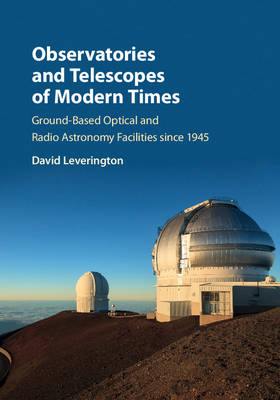
Observatories and Telescopes of Modern Times
Cambridge University Press (Verlag)
978-0-521-89993-2 (ISBN)
This volume gives an historical overview of the development of professional optical and radio observatories from 1945 to today. It covers the environment in which these facilities were developed by organisations in the United States, Europe and elsewhere, often led by larger-than-life individuals, as well as exploring the financial and political factors that both constrained and encouraged progress. As ever more expensive optical facilities were built, they exploited new technologies to significantly improve their performance: CCDs, active and adaptive optics, and spun honeycomb and segmented mirrors. The second half of this volume turns to the parallel history of radio astronomy facilities throughout the world, finishing with the ALMA observatory in Chile. This is the ground-based companion to the author's previous work on space astronomy, New Cosmic Horizons (2001). It is written for both technical and non-technical readers interested in the modern history of astronomy and its observational facilities.
David Leverington received his degree in Physics from the University of Oxford in 1963. Since then he has held a number of senior positions in the space industry, working for both the European Space Agency and British Aerospace before taking early retirement in 1992. Subsequently he has written four books: A History of Astronomy from 1890 to the Present (1996), New Cosmic Horizons: Space Astronomy from the V2 to the Hubble Space Telescope (Cambridge, 2001), Babylon to Voyager and Beyond: A History of Planetary Astronomy (Cambridge, 2003) and the Encyclopedia of the History of Astronomy and Astrophysics (Cambridge, 2013). He was also technical consultant for ABC-CLIO's Space Exploration and Humanity: A Historical Encyclopedia (2010), supported by the History Committee of the American Astronautical Society.
Preface; Part I. Optical Observatories: 1. Palomar Mountain Observatory; 2. The United States Optical Observatory; 3. From the Next Generation Telescope to Gemini and SOAR; 4. Competing primary mirror designs; 5. Active optics, adaptive optics and other technical innovations; 6. European Northern Observatory and Calar Alto; 7. European Southern Observatory; 8. Mauna Kea Observatory; 9. Australian optical observatories; 10. Mount Hopkins' Whipple Observatory and the MMT; 11. Apache Point Observatory; 12. Carnegie Southern Observatory (Las Campanas); 13. Mount Graham International Optical Observatory; 14. Modern optical interferometers; 15. Solar observatories; Part II. Radio Observatories: 16. Australian radio observatories; 17. Cambridge Mullard Radio Observatory; 18. Jodrell Bank; 19. Early radio observatories away from the Australian-British axis; 20. The American National Radio Astronomy Observatory; 21. Owens Valley and Mauna Kea; 22. Further North and Central American observatories; 23. Further European and Asian radio observatories; 24. ALMA and the South Pole; Name index; Optical observatory and telescope index; Radio observatory and telescope index; General index.
| Erscheinungsdatum | 12.11.2016 |
|---|---|
| Zusatzinfo | 11 Tables, black and white; 91 Halftones, black and white |
| Verlagsort | Cambridge |
| Sprache | englisch |
| Maße | 178 x 253 mm |
| Gewicht | 1120 g |
| Themenwelt | Sachbuch/Ratgeber ► Natur / Technik |
| Geschichte ► Teilgebiete der Geschichte ► Technikgeschichte | |
| Naturwissenschaften ► Physik / Astronomie ► Astronomie / Astrophysik | |
| Technik | |
| ISBN-10 | 0-521-89993-1 / 0521899931 |
| ISBN-13 | 978-0-521-89993-2 / 9780521899932 |
| Zustand | Neuware |
| Haben Sie eine Frage zum Produkt? |
aus dem Bereich


